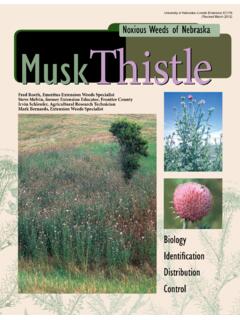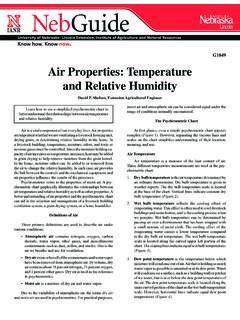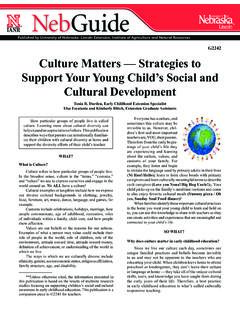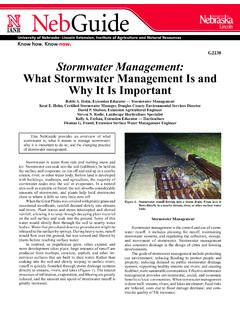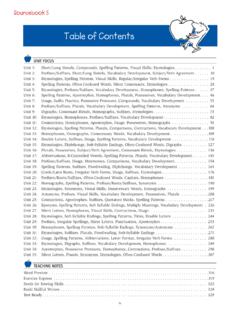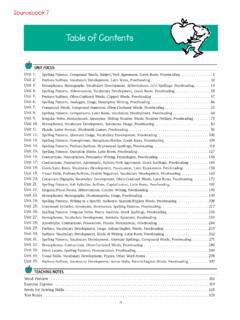Transcription of Skillful Grazing Management on Semiarid Rangelands
1 EC162 EXTENSIONI ntroductionAn acre of Semiarid rangeland may contain more than a million grass tillers, most of which will die back to ground level by the end of the growing season in October. Understanding the annual processes of repopulation and seasonal growth patterns of common rangeland grasses is the cornerstone of skilled Grazing conditions generally occur where annual precipitation ranges from 10 to 20 inches and evening air temperatures are measurably lower than daytime temperatures during much of the summer. The western half of Nebraska is Semiarid with a relatively wide transition zone in central Nebraska between consistently Semiarid and consistently sub-humid areas.
2 Semiarid regions are characterized by dynamic year-to-year variation in the timing and quantity of precipitation and the ever-present risk of Grazing managers use their knowledge of grass growth to select Grazing systems and to make year-to-year changes in pasture-use sequences that minimize cumulative effects of Grazing and drought stress. They optimize the vigor and forage production potential of their rangeland grasses in pre-drought years, which is Phase I of every effective drought Management plan. When drought occurs, critical dates for reducing stocking rates in the next phases of a drought Management plan correspond to rapid-growth windows, 30-day intervals during which codominant grasses normally grow most rapidly.
3 There is little hope of measurable yield response to rainfall after drought has continued into the midpoint of these rapid-growth windows. Skillful Grazing managers use the concepts in this publication to improve the profitability and longevity of their range livestock tiller is the smallest stand-alone unit of a grass. Basic components of a tiller include a shoot, a crown and roots (Figure 1). Tillers originate from vegetative buds that develop on the crowns (Figures 2a and b), stolons (Figure 3a) or rhizomes (Figures 4b and d) of intact or parent tillers, or from seed. When tillers originate from seed, the process is referred to as sexual reproduction because the seed is produced by male and female floral parts.
4 In contrast, repopulation from nonfloral vegetative buds on existing plants is asexual or vegetative reproduction. Genetic information needed for the growth and development of all plant parts is contained in meristematic tissue in seeds and buds. Patrick E. Reece, Extension Rangeland Ecologist; Walter H. Schacht, Range Management Scientist; Jerry D. Volesky, Extension Range and Forage Specialist 2007, The Board of Regents of the University of Nebraska on behalf of the University of Nebraska Lincoln Extension. All rights Grazing Managementon Semiarid RangelandsGrass seed production on Semiarid rangeland is limited by timing or quantity of precipitation in most years.
5 When viable seed is produced, much of it is consumed by birds, small mammals, or invertebrates such as ants or beetles. Species diversity and quantity of viable perennial grass seed in the top soil of Rangelands are amazingly low. Consequently, year-to-year replacement of grass tillers primarily depends on the production and survival of vegetative buds. Additionally, roots produced by previously established tillers and carbohydrates from parent tillers greatly enhance survival and growth of tillers from vegetative buds compared to seedlings. Few perennial grasses become established from seed on growing conditions are favorable and plants are not overgrazed, perennial grasses produce new buds every year and supply energy needed to maintain preceding-year cohorts of dormant buds.
6 Generally, only a portion of the buds in perennial grasses break dormancy and develop into tillers in a given growing season. Dormant buds are inactive meristematic tissue. They may be nondifferentiated (Figures 4d, 5c) or differentiated (Figures 4b, 5a). Differentiated buds often begin growth in the fall and delay emergence until the following spring. The remaining buds will be viable for several years if the tiller network supplies the energy needed to maintain the relatively small amount of live tissue in dormant ReproductionBunchgrasses do not have stolons or rhizomes and instead develop dense clusters of tillers.
7 Examples include little bluestem, needleandthread and prairie junegrass. Bunchgrasses repopulate primarily by tillering. New tillers develop in close proximity to current-year and previous-year tillers because buds primarily are located in the crown at the lower most nodes of parent tillers. Multiple generations of buds often are discernible in bunchgrasses (Figure 2). Density, size and orientation of buds differ among grasses have stolons or rhizomes. Buffalograss reproduces vegetatively by tillering from nodes (Figure 3a)on stolons (Figure 3b). Stolons are above-ground horizontal stems that root at the tip or at nodes.
8 Buds on the crowns of buffalograss (Figure 3a) may differentiate into tillers or stolons. Western wheatgrass, prairie sandreed, switchgrass and sand bluestem are rhizomatous. These species reproduce vegetatively when tillers develop from buds on rhizome nodes (Figure 4b), the end of rhizomes (Figure 5a) or on the crowns of parent tillers (Figure 5c). Rhizomes are underground stems that produce roots at nodes. Continuous rhizomes produce aerial shoots from buds located at nodes and the rhizome continues to grow under ground (western wheatgrass, Figure 4). In contrast, rhizomes that turn up and emerge as a green shoot are referred to as terminal rhizomes (prairie sandreed, Figure 5; sand bluestem, Figure 6).
9 The anatomy of rhizomes is similar among species; however, there is considerable diversity in physical characteristics. Rhizomes are composed of nodes and internodes. Buds, roots and rhizome scales can originate from nodes of rhizomes (Figure 4). Elongation of rhizome internodes is pronounced in western wheatgrass (Figure 4d) and sand bluestem (Figure 6b). Internode elongation is intermediate in prairie sandreed rhizomes (Figure 5d), and very limited in switchgrass rhizomes (Figure 7). Western wheatgrass rhizomes (Figure 4) are long and thin, resulting in widely dispersed populations of connected tillers. This contrasts with the short, stout, scaly, multi-branched rhizomes of switchgrass (Figure 7).
10 Sand bluestem rhizomes (Figure 6) turn upward early in growth. This growth form contrasts with prairie sandreed (Figure 5) with most of the rhizomes growing horizontally until the terminal rhizome bud differentiates into a practices that periodically optimize growth of new rhizomes are likely to increase the spread and productivity of rhizomatous grasses. The largest tillers of rhizomatous grasses often originate from the distal, pointed end of terminal rhizomes. Rhizomes also are important for carbohydrate storage and translocation among interconnected tillers. Season of GrowthRangeland plant communities are composed of mixtures of species that grow at different times during the spring or summer.
